This post may contain affiliate links which may generate a small commission from clicks that result in a purchase.
Fertilizer is one of the essential aspects of care and maintenance for your olive trees, particularly if you don’t live in their native Mediterranean climate.
The best fertilizer for olive trees is a slow-release fertilizer with an NPK of 20-10-10, focusing on nitrogen, phosphorus, and potassium. Specially blended TreeHelp Premium Fertilizer for olive trees feeds the tree with nutrients over several months and is ideal for olive trees. As a result, it boosts olive tree growth, increases fruit yield, and makes them pest-free.
It’s important not to over-fertilize olive trees, which can lead to excessive vegetative growth and reduce fruit production. Fertilizing once or twice a year, in early spring and after harvest, is generally sufficient. It’s also essential to follow the manufacturer’s instructions and to avoid fertilizing in hot, dry weather, as this can damage the tree’s roots.
Without the right blend of nutrients, you’ll end up with a neglected tree or, even worse, undeveloped or wrinkled olives.
In this guide, learn everything you need to know about choosing and using the best fertilizer for olive trees.
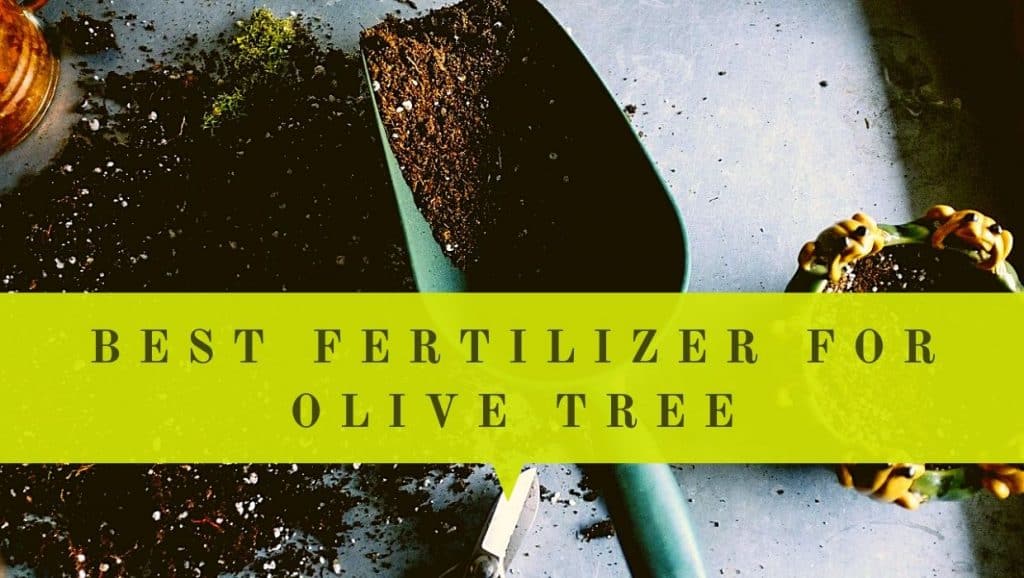
I. Best Fertilizers for Olive Trees
The best fertilizer for olive trees is balanced and provides adequate nitrogen, phosphorus, potassium, and micronutrients like iron, zinc, manganese, boron, and copper for optimal growth and development.
1. TreeHelp Premium Fertilizer for Olive
Last update on 2024-07-13 / Affiliate links / Images from Amazon Product Advertising API
If you’re looking for the best fertilizer for your olive trees in pots or on the ground, look no further than TreeHelp Premium Fertilizer for Olive. This product has been specially selected to provide all the nutrients your trees need to thrive and better fight off insects and diseases. Let’s explore the benefits of this fantastic fertilizer!
Promotes Overall Tree Health
TreeHelp Premium Fertilizer contains an optimal mix of macro- and micronutrients that encourage strong root development and increased disease resistance.
The slow-release nitrogen ensures your tree gets the nutrients it needs without causing weak new growth or making it more vulnerable to pests and weather damage. This means your olive tree will be healthy, robust, and ready to take on whatever Mother Nature throws at it!
High Quality
When it comes to fertilizing your olive trees, quality matters. TreeHelp Premium Fertilizer contains top-quality ingredients specifically chosen to benefit your tree. The custom formulations are designed just for TreeHelp, ensuring you get the best product for your olive trees.
Long Lasting
One of the best features of TreeHelp Premium Fertilizer is its slow-release nitrogen, which will continue feeding your tree throughout the entire growing season. No need to worry about frequently reapplying – this fertilizer has covered you!
Great Coverage
A single 3.3 LB (1.5 Kg) bag of TreeHelp Premium Fertilizer is designed to treat one mature tree or 2-3 smaller, newly planted, or potted trees. This means you’ll get excellent value for your money while providing your trees with the nutrients they need to flourish.
In summary, TreeHelp Premium Fertilizer for Olive is an optimal blend of nutrients, long-lasting formula, and top-quality ingredients your olive trees will thank you for.
It is for standard use for olive trees without any infestations. If your olive tree becomes problematic, I recommend the effective organic Neem seed oil described below.
2. Organic Neem Bliss
Last update on 2024-07-13 / Affiliate links / Images from Amazon Product Advertising API
Have you been searching for an organic, highly effective fertilizer to help your olive trees flourish? Let me introduce you to Organic Plantonix Neem Bliss – an effective organic neem seed oil with the main active ingredient Azadirachtin.
This ingredient ensures your olive trees remain healthy from sapling to harvest. It is super effective to control the pests and diseases of your olive tree in pots. In particular, if you bring the potted olive tree indoors for winter.
Purest Neem Oil on the Market
Plantonix Neem Bliss is made from the freshest fruit kernels of the neem plant without using heat or additives. This cold press process ensures that all the essential nutrients are preserved, giving you the best possible results for your garden, soil, or irrigation system!
Organic fertilizer such as Neem oil for the olive tree is essential for soil health. It can be a solution to your tree problems and a protector for upcoming issues.
Highly Concentrated and Soluble
Plantonix Neem Bliss is highly concentrated and free of additives, making it perfect for use on farms, lawns, and indoor and outdoor gardens. The main active ingredient, azadirachtin, ensures that Neem Bliss is highly soluble and ideal for topical applications.
Ideally works when planting saplings or saving stressed, mature olive trees in pots. It works perfectly to revive and bring potted olive trees back to life.
Safe for Organic Use
Good news for those dedicated to organic gardening – Plantonix Neem Oil is listed by the Organic Materials Review Institute (OMRI) as a certified organic product!
Regular foliar application of Plantonix Neem Bliss will ensure your olive trees remain healthy from seed to harvest, giving you peace of mind knowing you’re using an environmentally friendly product.
The only downside of Neem oil is a relatively strong garlicky odor that some people do not like.
Overall, Neem Bliss is like a spa treatment for your olive tree and is completely safe to handle and recyclable. With its pure formulation, the easy-to-use application process, and OMRI certification, you can be confident that you’re giving your trees the best possible care. Try it, and watch your olive trees flourish like never before!
3. Olive Focus Concentrated Fertilizer
FOR THE UK MARKET
Last update on 2024-07-13 / Affiliate links / Images from Amazon Product Advertising API
Are you on the hunt for the perfect fertilizer to keep your olive trees looking gorgeous, healthy, and productive? Look no further, Olive Focus is a specially formulated fertilizer designed to provide optimum long-term growth for your olive trees.
Unique Balanced Formula
Olive Focus is one-of-a-kind liquid fertilizer precisely formulated for olives, making it a must-have product for those looking to take advantage of this increasingly popular plant. It is crafted from pure mineral salts and enriched with complex organic plant acids and pure concentrated kelp extracts. This urea-free blend perfectly balances nutrients for your olive trees, ensuring they thrive and produce fruit.
This fertilizer makes healthy olive trees in pots look even healthier. Olive trees that struggle to fruit often produce an impressive yield due to the high amount of potassium.
Seaweed and Humic Acid for Added Benefits
Olive Focus contains seaweed as an added nitrogen source and humic acid for long-term soil fertility. These ingredients work together to provide the best environment for your olive trees to flourish.
They assist in building a strong root system and helps the olive tree establish itself after being repotted. Massive effect on restoring the tree’s vigorous leaf and branch growth.
Versatile Application
Olive Focus is perfect for olive trees and great for bay, figs, acers, and most other garden trees grown in containers in the greenhouse or conservatory. The small volume of growing medium in these environments is no match for Olive Focus.
With its carefully balanced formula, unique concentration, and ease of use, your olive trees will thrive like never before. Say hello to beautiful, healthy, and fruit-producing olive trees with Olive Focus!
II. Benefits of Fertilizing Olive Trees
Fertilizing your olive tree offers a range of benefits, from improved growth and fruit production to better soil health and increased lifespan. These are the benefits when fertilizing olive trees, whether they’re potted or planted in the ground:
Enhanced Growth and Vigor
One of the most noticeable benefits of fertilizing your olive tree is the boost in growth and overall health. A well-nourished tree will have lush, vibrant foliage and a sturdy, robust structure. Proper fertilization encourages your tree to grow stronger, ensuring it can withstand harsh weather conditions and resist pests and diseases.
Improved Fruit Production
Who doesn’t love the taste of fresh, homegrown olives? Fertilizing your olive tree ensures it receives the nutrients required for optimal fruit production. A well-fed tree will produce larger, more abundant harvests, allowing you to enjoy the fruits of your labor (quite literally!).
Faster Recovery from Stress
Olive trees, like all plants, can experience stress from transplanting, pruning, or pest infestations. You can help your tree recover more quickly and bounce back stronger than ever by providing the nutrients it needs.
Better Soil Health
Fertilizing your olive tree benefits the tree itself and improves the surrounding soil’s health. Adding essential nutrients can improve the soil structure, promote beneficial microorganisms, and create a more hospitable environment for your tree’s roots.
Increased Lifespan
A well-fertilized olive tree is likelier to have a longer, healthier life. You’re giving your tree the best chance at a long, productive life by providing the nutrients it needs to grow and thrive. And who wouldn’t want to enjoy their olive tree for as long as possible?
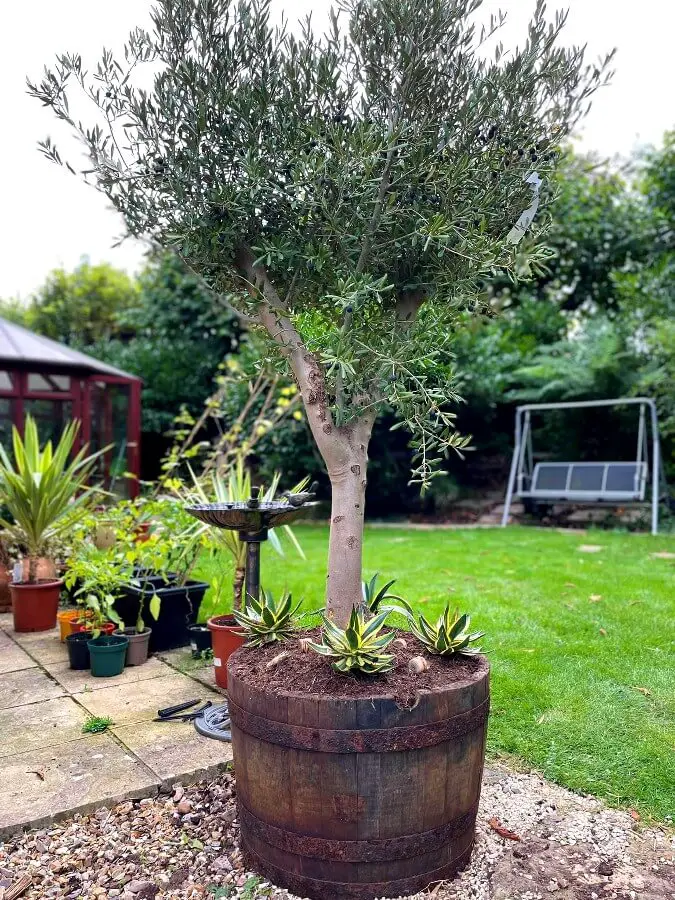
III. Olive Tree Nutritional Requirements
Understanding the nutritional requirements for your olive tree is vital information that helps your tree to thrive, and here is why.
1. Macronutrients: N-P-K Importance
NPK is the nitrogen, phosphorus, and potassium ratio an olive tree and other plants require. These three nutrients help trees to stay healthy and grow strong, and each nutrient plays its role described below.
Nitrogen (N)
N stands for Nitrogen and is one of the primary essential nutrients for olive trees. Its main responsibility in a potted olive tree is vegetative growth.
Nitrogen is essential for leafy growth and photosynthesis. It helps produce chlorophyll, which gives leaves their green color, and also promotes strong, healthy roots.
Phosphorus (P)
Another important nutrient for olive trees is phosphorus (P). Phosphorus supports root development, flowering, and fruit production. It’s vital for strong, resilient trees that can withstand environmental stress.
Potassium (K)
Last but not least is the nutrient potassium (K). It works more indirectly than the other two nutrients. Potassium is necessary for water and nutrient movement within the plant. It also aids photosynthesis, strengthens cell walls, and contributes to disease resistance.
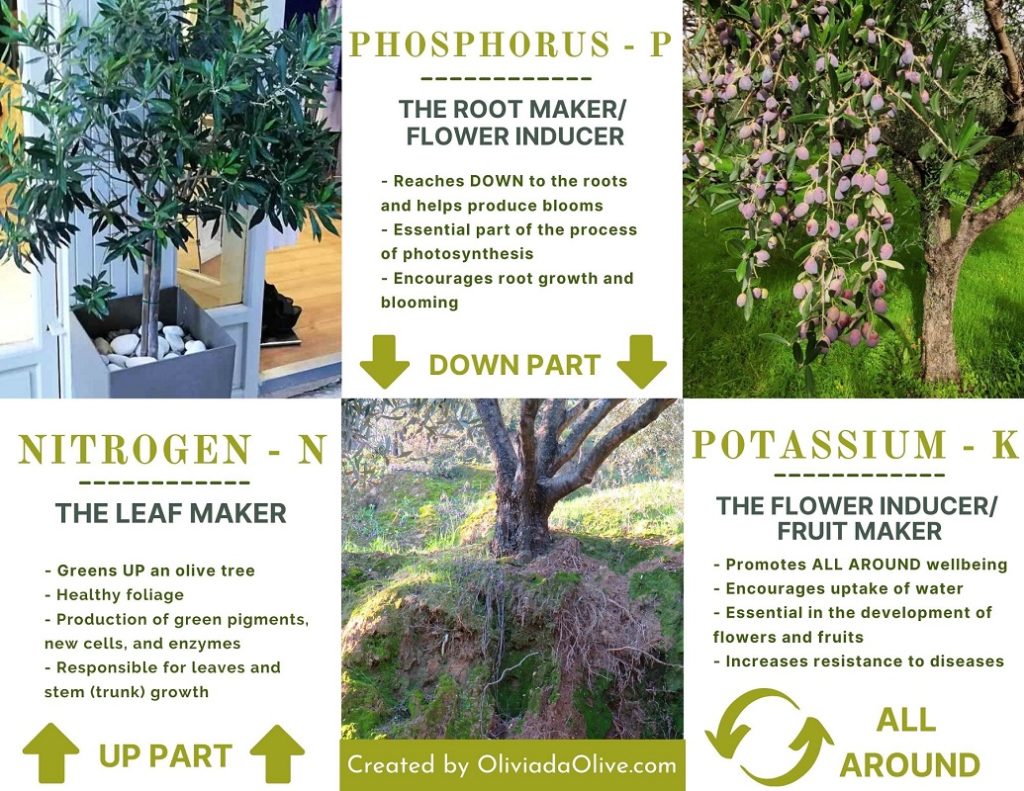
2. Micronutrients Value
Micronutrients, though required in smaller amounts than macronutrients, are still crucial for the overall health and development of your olive trees. Here are the key micronutrients to keep in mind:
- Iron (Fe): Iron is necessary for chlorophyll production, which supports photosynthesis and overall plant health.
- Zinc (Zn): Zinc plays a role in growth regulation, enzyme activity, and fruit development. A deficiency can lead to stunted growth and poor fruit set.
- Manganese (Mn): Manganese aids in photosynthesis, enzyme activation, and overall plant growth. It increases yields.
- Boron (B): Boron is essential for cell wall structure, nutrient uptake, and fruit development.
- Copper (Cu): Copper helps with enzyme activation, chlorophyll production, and overall plant health.
- Magnesium (Mg): Magnesium moves carbohydrates from leaves to other parts of the olive tree and helps for the olive fruiting stage.
| Essential Nutrient | Function | Deficiency Symptoms |
|---|---|---|
| Nitrogen (N) | Promotes leaf and shoot growth | Yellowing leaves, stunted growth |
| Phosphorus (P) | Supports root development, flower, and fruit production | Purple or red leaf tints, poor root growth |
| Potassium (K) | Enhances disease resistance, improves fruit quality | Leaf curling, browning leaf edges |
| Iron (Fe) | Necessary for chlorophyll production | Interveinal yellowing, pale leaves |
| Zinc (Zn) | Supports enzyme function and protein synthesis | Leaf mottling, small leaves, poor fruit set |
| Manganese (Mn) | Important for photosynthesis, respiration, and nitrogen metabolism | Interveinal yellowing, poor growth |
| Boron (B) | Affects cell division and development, necessary for sugar transport | Terminal bud dieback, poor fruit set |
| Copper (Cu) | Involved in enzyme activation and photosynthesis | Leaf curling, stunted growth, poor fruit set |
3. Soil pH and Nutrient Availability
The soil pH impacts nutrient availability for your olive trees. The optimal pH range for olive trees is slightly acidic to neutral, between 6.0 and 8.0. This range ensures that the essential nutrients are easily accessible for your trees to absorb and utilize effectively.
So, why does pH matter? Here’s the scoop:
Nutrient Solubility
The solubility of nutrients is directly affected by soil pH. When the pH is within the optimal range, nutrients become more soluble and are more readily available for uptake by the tree’s roots.
Nutrient Lock-Out
If the soil pH is too high (alkaline) or too low (acidic), it can lead to nutrient lock-out. This means that essential nutrients, such as phosphorus, iron, and zinc, become unavailable to your olive trees, which can result in nutrient deficiencies and poor growth.
Microbial Activity
Soil pH also impacts the activity of beneficial microbes in the soil. These microbes break down organic matter and release nutrients to your olive trees. An optimal pH range supports a healthy and diverse microbial population, promoting better nutrient availability for your trees.
In conclusion, maintaining the correct soil pH is just as important as providing your olive trees with the essential nutrients they need. By ensuring your soil is within the optimal pH range, you’ll be giving your trees the best possible environment for growth, development, and fruit production.
IV. What to Look For When Buying Fertilizer
When shopping for fertilizers for your olive trees in pots, you must consider some factors before deciding. I’ve curated this detailed buying guide to help you find the top olive tree fertilizer.
1. NPK Ratio
NPK ratio in a fertilizer refers to the proportion of three essential nutrients – nitrogen (N), phosphorus (P), and potassium (K).
Choose the NPK ratio depending on your olive tree needs. For example,
- Pick nitrogen(N)-rich fertilizer if you want your tree to thrive.
- If you have just transplanted an olive tree, choose phosphorus(P)-focused fertilizer to encourage root growth and blooming.
- You can select potassium(K)-rich fertilizer to improve flowering and fruiting.
The NPK ratio is usually displayed on the packaging of commercial fertilizers as three numbers separated by dashes, for example, 20-10-10. The first number indicates the percentage of nitrogen, the second number indicates the % of phosphorus, and the third number indicates the % of potassium.
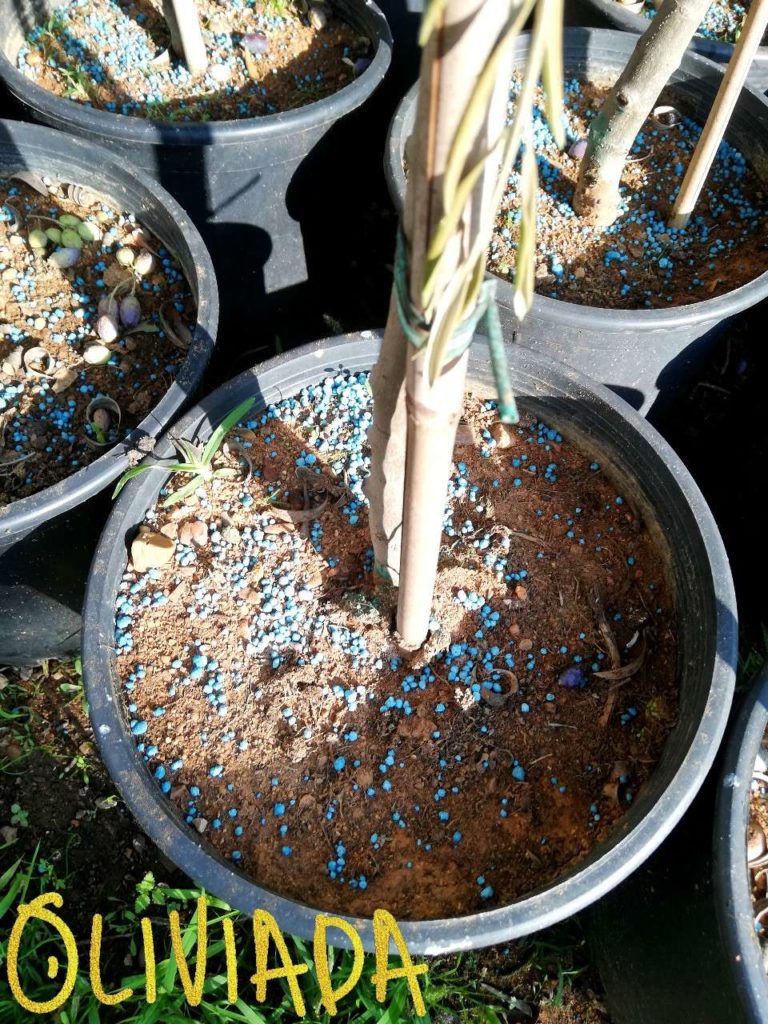
2. For Healthy Olive Tree
For general use, olive trees need a fertilizer containing high-source nutrients, particularly nitrogen. So the best fertilizer for olive trees is nitrogen-rich or balanced NPK fertilizer with a 2:1:1 formula.
The established olive tree requires a balanced fertilizer with a 20-10-10 formula.
3. For Olive Tree With Problems
If your potted olive tree has pest problems, you may want to try a popular Neem oil (listed above). This organic oil is very good for protecting your olive tree from pests or diseases, and use it as a prevention.
If your olive tree looks neglected and has discoloration of leaves, then before choosing a fertilizer, you should conduct a soil test and leaf analysis to know exactly what the olive tree needs. By doing that, you learn what minerals your potted olive tree needs.
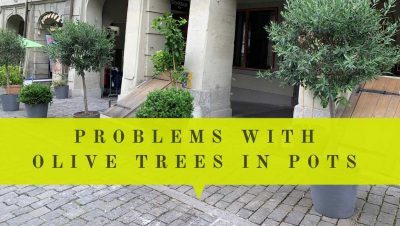
4. Organic vs. Synthetic Fertilizers
You may ask which fertilizer to use for your olive trees: organic or synthetic. Here is a brief answer to help you decide:
Synthetic fertilizers
Synthetic fertilizers allow for precise nutrient ratios, ensuring that your olive trees receive the exact amounts of nitrogen, phosphorus, and potassium they need to thrive. Synthetic fertilizers also quickly release nutrients, making them an excellent choice for gardeners looking to address specific nutrient deficiencies or provide a quick boost to their olive trees’ growth.
The great thing is that most of them are blended and formulated for specific tree needs.
However, incorrect or over-application may burn olive trees due to high concentrations of chemical nutrients, like salts.
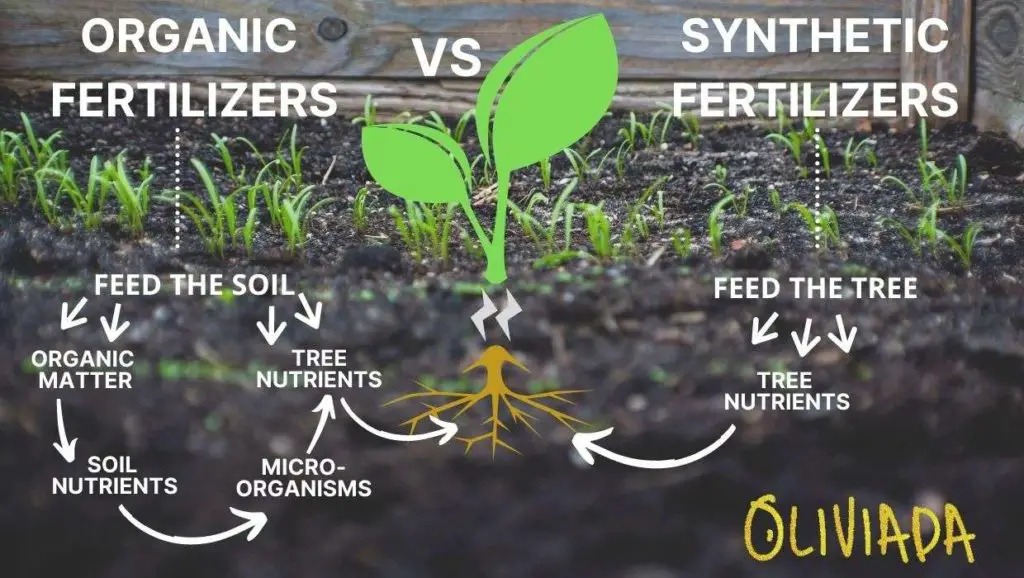
Organic fertilizers
Organic fertilizers are environmentally friendly, as they come from natural sources and break down naturally without harming the soil or surrounding ecosystem. Organic fertilizers from organic sources benefit olive trees and soil over time for better composition, texture, structure, drainage, and aeration. Furthermore, they provide a slow release of nutrients, reducing the risk of over-fertilizing and allowing olive trees to absorb nutrients more effectively.
Organically derived fertilizers typically have a lower NPK analysis (nitrogen, phosphorus, potassium) than synthetic fertilizers, but they feed olive trees much longer.
As a result, the impact of organic fertilizers on olive trees may take a little longer, but the reward is a tree and soil that stays balanced longer.
For fast, problem-solving, and impressive results at an economical price, synthetic fertilizers are hard to beat.
But if you’re trying to build your soil long-term or you’re into organic gardening, organic fertilizer is the way to go.
For more about organic fertilizers, check out in my article: organic fertilizers for olive trees.
| Aspect | Synthetic Fertilizers | Organic Fertilizers |
|---|---|---|
| Nutrient Release | Quick nutrient release | Slow-release nutrients |
| Nutrient Ratios | Precise nutrient ratios | Less precise ratios |
| Soil Health | May not improve soil structure | Improved soil structure |
| Environmental Impact | Potential for pollution and runoff | Environmentally friendly |
| Longevity | Short-term, may need frequent applications | Long-lasting, build-up over time |
| Cost | Generally cheaper | Often more expensive |
Looking for a Personalized Gift?
Adopt an OLIVE TREE in Greece –
Receive Premium Olive Oil!
V. Potted Olive Trees Fertilizing Plan
1. Frequency of Fertilization
Olive trees in pots are heavy feeders compared to wild olive trees , mainly due to the root restrictions they experience within the confines of their pots.
- During their active growing season (spring and summer), I recommend fertilizing your potted olive trees every 4-6 weeks. This ensures they receive a steady supply of nutrients for healthy growth.
- As the trees enter their dormant period (fall and winter), you can reduce the frequency of fertilization to every 1-3 months. This allows your trees to receive the necessary nutrients without overloading them when they’re not actively growing.
Note that the specific frequency and amount of fertilization will depend on the type of fertilizer you use. Always follow the instructions on the packaging to ensure you provide the right nutrients for your trees.
Be cautious when using granular plant food, especially for potted olive trees, as it can easily lead to overfeeding since it grows in a limited area in the pot. If you opt for granular plant food, make sure it’s specially formulated for olives and follow the brand’s guidelines for quantity and frequency.
| Potted Olive Tree Fertilizing Routine | Frequency of Fertilization | Factors to Consider | Climate Impact |
|---|---|---|---|
| Active Growing Season (Spring & Summer) | Every 4-6 weeks | – Type of fertilizer (follow packaging instructions) – Olive cultivar – Local climate | Warmer temperatures and longer daylight hours increase nutrient uptake and growth rates, requiring more frequent fertilization. |
| Dormant Period (Fall & Winter) | Every 1-3 months | – Type of fertilizer (follow packaging instructions) – Olive cultivar – Local climate | Cooler temperatures and shorter daylight hours reduce nutrient uptake and growth rates, requiring less frequent fertilization. |
Local climate plays a significant role in determining the fertilization frequency for potted olive trees. Here are some ways in which local climate impacts fertilization frequency:
- Temperature: Warmer temperatures encourage active growth in olive trees, increasing the need for nutrients. In regions with higher average temperatures during the growing season, you may need to fertilize more frequently to support this growth. On the other hand, cooler temperatures slow down growth, meaning the trees require less frequent fertilization.
- Precipitation: Rainfall can impact the availability and absorption of nutrients in the soil. In areas with heavy rainfall, nutrients may be washed away, necessitating more frequent fertilization to replenish them. Conversely, in regions with low rainfall, nutrients may be more concentrated in the soil, and trees may require less frequent fertilization.
- Seasonal changes: Olive trees have distinct growing and dormant periods, influenced by local climate factors such as temperature and daylight hours. In areas with specific seasonal changes, you may need to adjust your fertilization frequency to match the trees’ growth cycle. For instance, during the active growing season (spring and summer), trees require more frequent fertilization, while the dormant period (fall and winter) requires less frequent fertilization.
- Microclimates: Even within the same general area, microclimates can cause variations in temperature, precipitation, and other factors that impact fertilization frequency. For example, trees in a sheltered spot may experience different growing conditions than those in an exposed location. You should monitor your trees’ health and growth and adjust the fertilization frequency based on their specific needs.
By considering the local climate and how it impacts your potted olive trees, you can develop a tailored fertilization schedule that provides the optimal nutrients for your trees to thrive.
Factors Influencing Fertilization Frequency
As an expert in growing and caring for olive trees, I’m excited to share some crucial factors to consider when developing your potted olive tree fertilizing plan. By considering the age, size, soil quality, and local climate, you’ll be better equipped to create a tailored fertilization schedule for your trees.
Age
The age of your olive tree plays a significant role in determining its nutrient requirements. Younger trees are actively establishing their root systems and require more frequent fertilization to support healthy growth. As trees mature, their growth rate slows down, and their nutrient requirements change. Keep this in mind as you plan your tree’s fertilization schedule.
Soil
The size of your potted olive tree will also impact its nutrient requirements. Larger trees with more foliage require more nutrients to support their growth, while smaller trees need less. Adjust your fertilization frequency to match your tree’s size to ensure it receives enough nutrients for optimal growth.
Soil Quality
Soil quality has a considerable impact on the availability of nutrients for your potted olive tree. Good-quality soil will retain moisture and nutrients more effectively than poor-quality soil.
Regularly check the soil in your pot and amend it as needed to maintain a healthy environment for your tree’s roots. Also, consider using a high-quality potting mix designed for olive trees to provide a nutrient-rich foundation for growth.
Last update on 2024-07-13 / Affiliate links / Images from Amazon Product Advertising API
Climate
As we’ve discussed before, local climate plays a significant role in determining the fertilization frequency for your potted olive tree. Temperature, precipitation, and seasonal changes can all influence nutrient uptake and overall growth rates. Be mindful of your local climate conditions and adjust your fertilization schedule to ensure your tree receives the nutrients it needs throughout the year.
| Factors | Impact on Fertilization Frequency | Frequency of Fertilization | Considerations |
|---|---|---|---|
| Age | Younger trees require more frequent fertilization; older trees require less frequent fertilization | Young trees: Every 3-4 weeks; Mature trees: Every 4-6 weeks (during active growth) | Younger trees require more frequent fertilization; older trees require less frequent fertilization. |
| Size | Larger trees require more nutrients; smaller trees require fewer nutrients | Small trees: Every 4-6 weeks; Medium trees: Every 3-4 weeks; Large trees: Every 2-3 weeks (during active growth) | Modify fertilization frequency to match the size of your potted olive tree |
| Soil Quality | Good-quality soil retains moisture and nutrients more effectively than poor-quality soil | Good quality soil: Every 4-6 weeks; Poor quality soil: Every 3-4 weeks (during active growth) | Regularly check and amend soil quality, and use a high-quality potting mix designed for olive trees |
| Climate | Temperature, precipitation, and seasonal changes impact nutrient uptake and growth rates | Varies based on specific climate conditions (see previous discussion on local climate) | Monitor local climate conditions and adjust fertilization schedule accordingly |
2. Timing of Fertilization
Begin fertilizing in early spring
Early spring is the perfect time to kick off your potted olive tree’s fertilization schedule. As the days get longer and temperatures rise, your tree will enter its active growing season. By starting your fertilization plan in early spring, you’ll provide your tree with the nutrients it needs to support new growth and maintain its health throughout the year.
Fertilize during the growing season
Continue fertilizing your potted olive tree every 4-6 weeks throughout the active growing season, which typically lasts from spring through summer. This frequency ensures that your tree can access the necessary nutrients as it grows and develops new foliage. Monitor your tree’s health and adjust the fertilization frequency as needed based on its growth and the factors discussed earlier.
Reduce fertilization during dormancy
As the weather cools down and daylight hours decrease, your olive tree will enter its dormant period, usually from fall to winter. During this time, its growth rate slows, requiring fewer nutrients. Adjust your fertilization schedule accordingly, reducing the frequency to every 1-3 months. This will help maintain the tree’s health while preventing over-fertilization, which can cause harm.
Avoid fertilizing right before winter
avoid fertilizing your potted olive tree right before winter, as this can encourage new growth that may be susceptible to frost damage. Instead, aim to complete your final fertilization of the year at least 4-6 weeks before the first expected frost.
Observe your olive tree
Observe the physical appearance and growth to know the best time frames for fertilizing activities for your potted tree.
If olive tree leaves look grey-green, the tree looks lush and is holding onto olive fruit; this means you do not need to fertilize the tree as often.
If your olive tree looks healthy, but you fertilize it too often, it can affect the flowering stage and production of fruits. However, when olive tree flowers, it is the most nutrient-hungry stage and feeding your olive tree following fertilizer instructions is good. This will ensure the olive tree has enough nutrients to harvest well.
Additionally, it’s essential to follow the instructions on the fertilizer package and not over-fertilize, as this can also harm the tree.
3. How to Fertilize Olive Trees in Pots
When you have chosen the best fertilizer for your olive tree, here are the steps to fertilize your olive tree effectively and provide it with the nutrients it needs to grow healthy.
Prepare the Fertilizer
If you’re using a granular fertilizer, measure the recommended amount according to the package instructions. For liquid fertilizers, dilute the concentrate with water as directed. Be sure to mix well to ensure an even distribution of nutrients.
Apply the Fertilizer
For surface application, evenly distribute the granular fertilizer around the tree’s base, covering the soil’s surface.
If using liquid fertilizer, pour it evenly over the soil, not splashing the tree trunk or foliage.
When using foliar sprays, apply the solution to both the upper and lower surfaces of the leaves, ensuring full coverage.
Water Your Tree
After applying the fertilizer, water your potted olive tree thoroughly. This will help distribute the nutrients evenly throughout the soil and ensure they reach the tree’s roots. Be mindful of your tree’s specific water requirements and avoid overwatering, which can lead to root rot and other issues.
Monitor and Adjust
Keep a close eye on your tree’s health and growth after fertilizing. Adjust your fertilization schedule or technique as needed if you notice any signs of nutrient deficiency or over-fertilization. Age, size, soil quality, and climate can all influence how often you’ll need to fertilize your potted olive tree.
For olive trees in pots, I do not recommend spikes. No matter if it is easy to apply, it can overfeed the tree because its roots have limited space in the pot and can burn.
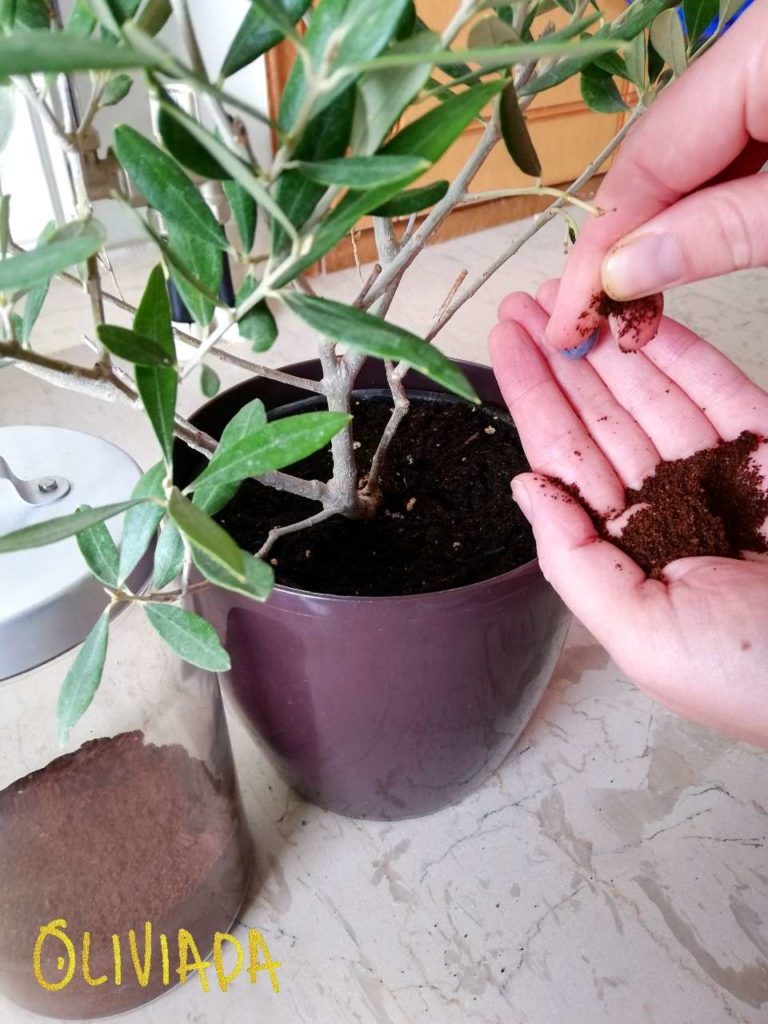
VI. Tips for Succesful Olive Tree Fertilization
1. Soil Testing for Accurate Fertilization
Soil testing can make all the difference in your olive tree fertilization journey, ensuring trees get the precise nutrients they need to flourish.
Each olive tree has unique nutritional requirements based on variety, age, and location. To ensure we’re meeting these needs, better to know what’s happening beneath the surface. That’s where soil testing comes in!
A soil test will give you valuable insight into your soil’s nutrient levels, pH, and overall health. With this information, you can make well-informed decisions about the type and amount of fertilizer your olive tree needs. It’s like having a tailor-made recipe for success!
Last update on 2024-07-13 / Affiliate links / Images from Amazon Product Advertising API
Now, you might be wondering how to get started with soil testing. It’s easier than you think! You can pick up a soil testing kit from your local garden center or order one online. Then, follow the instructions to collect soil samples and analyze them.
After you test the soil, you can fine-tune your fertilization plan, selecting the ideal fertilizer to nourish your trees and help them thrive.
2. Monitoring Tree Growth and Health
Keeping a close eye on your tree will give you a great sense of accomplishment and help you catch any potential issues early on.
First things first: get to know your olive tree. Observe its leaves, branches, and fruit, and note any changes. Regularly inspecting your tree can help you identify signs of nutrient deficiency, pest infestations, or other health issues.
One great tip is to keep a gardening journal to track your tree’s progress and document any changes or concerns. This can be especially helpful in tracking patterns or trends indicating a need to adjust your fertilization plan.
When monitoring your tree’s growth, consider seasonal changes and weather conditions. For example, you might expect more vigorous growth and fruit production in spring and summer, while winter may bring dormancy. Understanding these natural fluctuations can help you decide when and how to fertilize your tree.
Lastly, don’t forget to enjoy the process! Watching your olive tree grow, develop, and produce fruit is one of the most rewarding aspects of gardening. As you become more in tune with your tree’s needs, you’ll be well on your way to mastering the art of olive tree fertilization.
3. Adjusting Fertilization Plans
In this section, I’ll share some of my expert experience in adjusting fertilization plans based on your tree’s response and environmental factors. Because let’s face it, no two trees or growing conditions are the same, so flexibility is key!
Remember, even when your fertilization plan is in place, it’s not set in stone. Keep a watchful eye on your tree’s response to the fertilizers you use. It might be time to adjust your fertilizer type or application rate if you notice signs of nutrient deficiency, such as yellowing leaves or poor fruit production.
Similarly, you might be over-fertilizing if your tree appears to be growing too quickly or has an excess of foliage with little fruit. In this case, consider scaling back on the amount of fertilizer you’re applying or switching to a different formula with a more suitable nutrient balance.
Don’t forget that environmental factors can also influence your tree’s nutrient needs. For example, extended periods of drought or heavy rainfall can affect your soil’s nutrient levels and your tree’s ability to absorb them. Be prepared to adjust your fertilization plan in response to these changing conditions, ensuring your tree remains happy and healthy no matter what Mother Nature throws its way.
Remember, the key to successful olive tree fertilization is in tune with your tree and its needs. By staying observant and adapting your fertilization plan as needed, you’ll be well on your way to growing strong, fruitful olive trees.
VII. Frequently Asked Questions
Are Coffee Grounds Good Fertilizer For Olive Trees?
Coffee grounds can be a good source of nitrogen, phosphorus, and potassium, essential nutrients for olive tree growth. u003cbru003eHowever, they can also be quite acidic. So applying coffee grounds in your olive tree pot can help acidify the soil with a low pH level.u003cbru003eAdditionally, it’s important to note that coffee grounds should be used as a supplement to, rather than a replacement for, a balanced fertilizer regimen for olive trees.
Are Eggshells Good Nutrition For Potted Olive Trees?
Eggshells can be a good source of calcium for olive trees, an essential nutrient for their growth and development. Calcium is necessary for proper root development, cell wall structure, and nutrient uptake. u003cbru003eHowever, eggshells alone may not provide sufficient calcium and other nutrients that olive trees need. Using eggshells in combination with other fertilizers is recommended to provide a balanced nutrient supply for olive trees. u003cbru003ePlacing crushed eggshells inside the pot of your olive tree is a great way to give natural organic nutrients. Even with a small quantity, it will help boost your olive tree’s growth.
Is Tomato Feed Good For Olive Trees?
Tomato feed can be used as a fertilizer for olive trees to increase fruit production because it is typically high in potassium.u003cbru003eHowever, tomato feed should be balanced with other fertilizers and not be the sole source of nutrients for olive trees. It is important to ensure that the trees get sufficient nitrogen, phosphorus, and other nutrients.
How to Use TreeHelp Fertilizer?
For the potted olive tree, use only about 1/4 cup on a tree with it gently worked into the top inch of the soil. u003cbru003eWith potted trees, it is best to use less but replenish it more often due to the higher level of nutrient leaching via the pot. u003cbru003eIf you move the tree indoors in the fall, fertilize it after the move to help it handle translation shock. Same as in the spring, moving the tree outdoors.u003cbru003eAs the fertilizer breaks down, replenish with the potted trees as needed. Add a little every 2 to 3 months, as it is a slow-release fertilizer.
Should I use organic or synthetic fertilizers for my olive trees?
Both organic and synthetic fertilizers have their advantages and disadvantages. Organic fertilizers are more environmentally friendly and improve soil structure, while synthetic fertilizers offer precise nutrient ratios and quicker nutrient release. The choice depends on your preferences and the specific needs of your olive tree.
What nutrients are essential for olive tree growth and development?
Olive trees require macronutrients such as nitrogen, phosphorus, and potassium and micronutrients like iron, zinc, manganese, boron, and copper for optimal growth and development.
Can I use the same fertilizer for potted olive trees and olive trees planted in the ground?
While some fertilizers can be used for potted and in-ground olive trees, you should follow the specific instructions provided by the manufacturer. Potted olive trees require more frequent fertilization due to their limited root space.
Searching for Premium Olive Oil?
Get OLIVIADA Olive Oil from Kalamata, GREECE!
VIII. Final Thoughts
As explored throughout this article, finding the best fertilizer for your olive tree is essential for its overall health, growth, and productivity. I’ve discussed top contenders like TreeHelp Premium Fertilizer for Olive, Organic Neem Seed Oil, and Olive Focus – each with unique benefits for nurturing your precious olive trees.
TreeHelp Premium fertilizer, available on Amazon USA, or <a aria-label="Olive Focus available on Amazon UK (opens in a new tab)" class="rank-math-link" href="http://Olive Focus 1 Litre. Specially formulated Liquid Plant Food for Olives” target=”_blank” rel=”noreferrer noopener nofollow”>Olive Focus, available on Amazon UK, is an excellent option.
Remember, proper fertilization impacts the long-term success of your olive trees, ensuring they remain strong and produce high yields. Also, remember each olive tree is different, and what works for one may not work for another.
It’s necessary not to apply fertilizer without observation. Monitor your tree’s growth and changes throughout the seasons, as it may give signals that indicate what it requires to develop and bear fruit effectively.
With dedication, care, and some trial and error, you’ll be on your way to cultivating healthy, vibrant, and fruit-bearing olive trees.
Read Next
Learn More
Hi, I’m Vangelis Kleftogiannis, the founder of Oliviada and an established olive oil expert from Kalamata, Greece. My expertise isn’t just in producing quality Extra Virgin Olive Oil, but also in the cultivation and care of olive trees themselves. I am deeply committed to sharing my knowledge and know-how, helping others understand the intricacies of olive tree growing and the creation of quality olive oil.
Are You Looking to Buy an Olive Tree?
If you are looking to add more potted trees or other plants to your orchard, or if you like to replace a neglected olive tree, the best places to get them are your local nursery or an online nursery.
One of the most reliable and the world's largest online nurseries is Fast Growing Trees. They deliver fast, neat, and healthy plants backed with a 30-day guarantee.







My sweet olive tree is in the ground. I live in Louisiana, notice there is moss on all of the branches and not many leaves. Do you know what the problem might be?
Hi June, sorry to hear your tree has some problems. Let’s try to help to revive it.
First, prune out the dead branches and all the leaves and twigs in the center of the tree, because they’re going to die anyway (lack of light,) and pruning them out allows more light to reach the outer areas of the tree.
Secondly, check the soil moisture with a moisture meter. If the soil is too dry, many of the falling leaves will be yellow and start drop. If most of the leaves are green, but dropping, the soil may be too wet. Check the soil moisture by testing it and then follow other steps in my guide on how to revive the olive tree.
Can I use natural fertilizer on my potted olive eg worm tea , liquid horse manure ?
Can I use natural fertiliser on my potted olive, eg.worm tea, liquid horse manure.
Hi George, yes, you can apply natural fertilizers, i.e. liquid horse manure which is a great source of slow-release nitrogen. Please read instructions carefully prior to using it for your tree as not to over-fertilize and damage a tree. However, do not use fresh natural fertilizers such as fresh horse manure – it can damage or kill your olive tree especially if it is a young tree due to high nitrogen concentration. Hope it helps. Happy olive tree growing!
Can I use citrus tone fertilizer for my potted olive tree? I use it for my lemon tree and it says avocado and citrus fertilizer? But I’m not finding a list of other plants that it works for?. Other suggestions would be great if that’s not an option. Thank you
Hi Maria, usually standard citrus tone fertilizers are high in nitrogen and suits for not only lemon trees, but nut trees, olive trees, and other plants. If on the label of your fertilizer is written that it works for citrus and avocado trees, then it should be absolutely fine with olive trees as well. For example, Espoma organic citrus tone works for all subtropical trees that like acidic soil: lemon, olive, fig, avocado, mango and others. Most important not to overfertilize. Happy growing! If you are interested in an olive tree growing and would like to ask questions or share pictures, recently I have created a Facebook community group you can join!
Hi, I have an olive grove, but my seedlings rot and dry out. What fungicide should I use for this?
Hi Hossein, sorry to hear your seedlings rot and dried out. It can be many reasons why it has happened. Poor drainage, overfertilization, root exposure to harsh temperatures, and so on. Any ideas in your case? First, you need to identify the root cause and then manage the treatment. Initially, the soil test would do a job. If it is root fungi, then you should diagnose the type of fungi or disease and apply a proper fungicide. Without a diagnosis, some fungicide may cause more damage to the roots than do good. If it is a fungal rot, then leave treating fungal infections to the local professionals. Only with further analysis it is difficult to apply the treatment and remove the cause.
Excellent information on olive trees.
I bought TreeHelp Complete Fertilizer for my little potted indoor olive tree (cannot plant it outdoors due to Canadian winters). The instructions that came with it are for large outdoor olive trees. The package included the fertilizer, mycorrhizal treatment, and biostimulant. I just need to know measurements…how much should I be using and how often.
Hi Patricia, you can always use granular fertilizer for potted plants even if the instructions point to trees planted in the ground only. As for this granular fertilizer, use 1 teaspoon per gallon (4 liters) of the soil. Sprinkle it around the tree trunk and deep water afterward. Fertilize every 3 months excluding the winter season. Hope it helps!